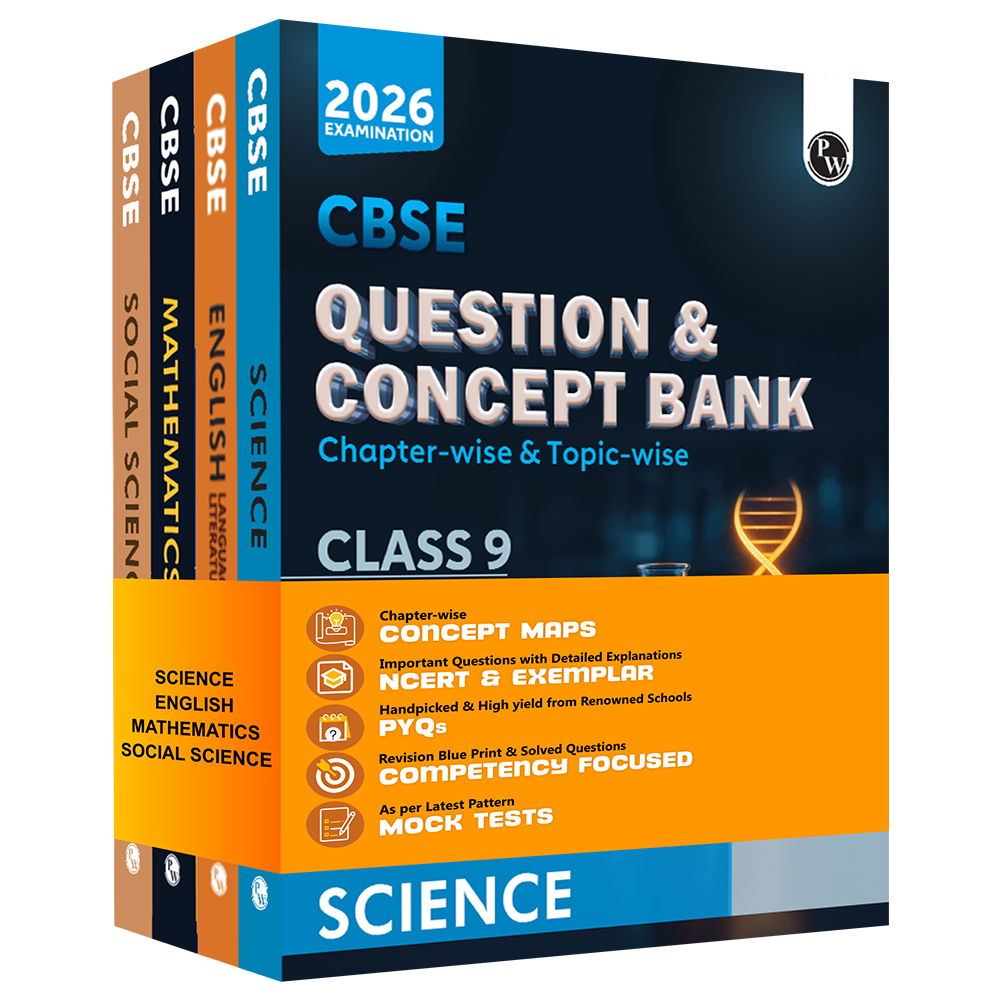CBSE Class 9 Exam Pattern 2025 with Marking Scheme

CBSE Class 9 Exam Pattern 2025 with Marking Scheme: Understanding the CBSE Class 9 exam pattern 2025 and marking scheme is crucial for students preparing for their annual exams. The Central Board of Secondary Education (CBSE) has structured the Class 9 curriculum to provide a balanced evaluation of students' conceptual clarity, analytical skills, and knowledge application across all subjects. In this detailed guide, we will break down the class 9 paper pattern, subjectwise marking scheme, topic weightage, and tips to prepare effectively for the upcoming exams.
Additionally, we will address one of the most common questions: "What are the passing marks out of 80 in CBSE Class 9?" Let’s look into the detailed breakdown.
CBSE Class 9 Exam Pattern 2025
The CBSE Class 9 paper pattern for 2025 ensures a comprehensive evaluation of students through a combination of objective questions, short answers, and long answers. The final exams consist of 80 marks, while an additional 20 marks are reserved for internal assessments, which include periodic tests, notebook submissions, and subject enrichment activities.
The CBSE Class 9 exam pattern focuses on testing both knowledge and skills. Students must focus on understanding concepts, practising problem-solving, and improving application-based learning to perform well.
Check out - CBSE Class 9 Books
CBSE Class 9 Question Types
Below is the subject-wise breakdown of Class 9 types of questions, topic-wise marks distribution, and the paper pattern for major subjects. Remember that the basic mark distribution for each subject is the same, i.e. 100 (80 Final Exam + 20 Internal).
|
Subject |
Question Types |
Key Focus Areas |
|
Mathematics |
|
Focus on logical reasoning, conceptual understanding, and problem-solving across all sections. |
|
Science |
|
Solve numerical problems, practice diagrams, and apply concepts in Physics, Chemistry, and Biology. |
|
Social Science |
|
Focus on analytical skills and understanding key events, concepts, and data interpretation. |
|
English |
|
Improve reading speed, grammar rules, and comprehension of literary texts. |
CBSE Class 9 Marking Scheme and Exam Pattern Subject-Wise
Check out the CBSE Class 9 Marking Scheme and Exam Pattern Subject-Wise below:-
CBSE Class 9 Maths Exam Pattern
-
The question paper is divided into five sections: A, B, C, D, and E.
-
Section A: Has 20 multiple-choice questions (MCQs), each question is for 1 mark.
-
Section B: Has 5 short-answer questions (SA-I), each question is for 2 marks.
-
Section C: Has 6 short-answer questions (SA-II), each question is for 3 marks.
-
Section D: Has 4 long-answer questions (LA), each question is for 5 marks.
-
Section E: Has 3 case-based questions. Each question is for 4 marks and includes sub-parts of 1, 1, and 2 marks.
-
All questions must be answered. Internal choices are available in:
-
2 questions of 5 marks,
-
2 questions of 3 marks, and
-
2 questions of 2 marks in Section E.
-
Draw clear diagrams wherever needed.
-
Use π = 22/7, unless mentioned otherwise.
Check out - CBSE Class 9 Sample Paper
CBSE Class 9 Maths Marking Scheme
Here is the CBSE Class 9 Maths Marking Scheme:-
|
S. No. |
Name of Unit |
Marks |
|
1 |
NUMBER SYSTEMS |
10 |
|
2 |
ALGEBRA |
20 |
|
3 |
COORDINATE GEOMETRY |
4 |
|
4 |
GEOMETRY |
27 |
|
5 |
MENSURATION |
13 |
|
6 |
STATISTICS & PROBABILITY |
6 |
|
TOTAL |
80 |
|
CBSE Class 9 Science Exam Pattern
-
This question paper has 39 questions, and you need to answer all of them.
-
The paper is divided into five sections: A, B, C, D, and E.
-
Here's what each section includes:
-
Section A: Questions 1 to 20 are multiple-choice questions, each worth 1 mark.
-
Section B: Questions 21 to 26 are very short answer questions. Each question carries 2 marks, and your answers should be between 30 to 50 words.
-
Section C: Questions 27 to 33 are short answer questions. Each question is worth 3 marks, and your answers should be 50 to 80 words long.
-
Section D: Questions 34 to 36 are long answer questions, each carrying 5 marks. These answers should be written in 80 to 120 words.
-
Section E: Questions 37 to 39 are case-based or source-based questions. Each question carries 4 marks and may have sub-parts.
-
There’s no overall choice in the paper, but some questions offer internal options. You can choose to answer only one of the alternatives provided in such cases.
Check out - CBSE Class 9 Revision Books
CBSE Class 9 Science Marking Scheme
Here is the CBSE Class 9 Science Marking Scheme:-
|
S. No. |
Unit |
Marks |
|
1 |
Matter - Its Nature and Behaviour |
27 |
|
2 |
The Organisation in the Living World |
26 |
|
3 |
Motion, Force & Work |
27 |
|
Total |
80 |
|
|
Internal Assessment |
20 |
|
CBSE Class 9 Social Science Exam Pattern
-
The question paper has five sections: A, B, C, D, and E.
-
There are 37 questions, and all of them are compulsory.
-
Section Details:
-
Section A: Questions 1 to 20 are multiple-choice questions (MCQs), each carrying 1 mark.
-
Section B: Questions 21 to 24 are very short answer questions, each carrying 2 marks. Answers should be within 40 words.
-
Section C: Questions 25 to 29 are short answer questions, each carrying 3 marks. Answers should be within 60 words.
-
Section D: Questions 30 to 33 are long answer questions, each carrying 5 marks. Answers should not exceed 120 words.
-
Section E: Questions 34 to 36 are case-based questions with three sub-parts, each carrying 4 marks.
-
Section F: Question 37 is map-based and carries 5 marks, divided into two parts:
-
37a: History (2 marks)
-
37b: Geography (3 marks)
-
Choices:
-
There are no overall choices in the paper.
-
However, internal choices are available for a few questions, but you must attempt only one of the options provided.
Read More - CBSE Class 9 Study: Tips and Strategies
CBSE Class 9 Social Science Marking Scheme
There are four subjects in CBSE Class 9 social science i.e., history, geography, political science and economics. Go through the CBSE Class 9 Social Science Marking Scheme below:-
|
Unit Name |
Marks |
|
Unit I India and the Contemporary World – II (History) |
20 |
|
Unit II Contemporary India – II (Geography) |
20 |
|
Unit III Democratic Politics – II (Political Science) |
20 |
|
Unit IV Economics |
20 |
|
Internal Assessment Periodic Assessment (5) + Portfolio (5) + Inter-Disciplinary Project (5) + Subject Enrichment Activity (Project Work) (5) |
20 |
|
Total |
80 + 20 |
CBSE Class 9 English Exam Pattern
-
This question paper has 11 questions, and all of them are compulsory.
-
The paper is divided into three sections:
-
Section A: Reading Skills
-
Section B: Grammar and Creative Writing
-
Section C: Literature Textbook
-
Follow the instructions given for each section carefully while attempting the questions.
CBSE Class 9 English Marking Scheme
Check out the CBSE Class 9 English Marking Scheme here:-
|
Section |
Weightage |
|
A. Reading Skills |
20 |
|
B. Writing Skills & Grammar |
20 |
|
C. Language through Literature |
40 |
|
Total |
80 |
What is the Passing Marks Out of 80 in CBSE Class 9?
-
Final Exam (Out of 80): Students need to score a minimum of 27 marks out of 80 in the final exam to pass.
-
Internal Assessment (Out of 20): Students must obtain at least 7 marks out of 20 in internal assessments (which include projects, assignments, periodic tests, etc.).
-
Overall Passing Marks (Out of 100): The combined total of marks from both the final exam and internal assessment should be 33 marks or more to pass the subject.
CBSE Class 9 Preparation Tips
Preparing for CBSE Class 9 exams requires a well-structured approach, as this year forms the foundation for higher studies. Here are some detailed preparation tips to help you succeed:
1. Understand the Syllabus
-
Start by thoroughly reviewing the CBSE Class 9 syllabus for all subjects. Understand the weightage of chapters to focus on high-priority topics first.
-
Subjects like Science and Mathematics often have higher weightage in exams, so plan accordingly.
2. Create a Study Schedule
-
Develop a weekly timetable with specific time slots for each subject. Allocate more time to challenging topics.
-
Dedicate time for regular revision to reinforce what you have learned.
3. Use Study Resources
-
Refer to NCERT textbooks as they are the primary source for exams.
-
Use additional guides, reference books, or online platforms.
.
4. Practice Regularly
-
Solve previous years’ question papers to understand the exam pattern and types of questions.
-
Attempt chapter-wise tests to strengthen conceptual clarity in individual topics.
5. Focus on Weak Areas
-
Identify topics where you face difficulties and allocate extra time to improve on them.
-
Seek help from teachers or peers if needed.
6. Take Notes and Revise
-
Make concise notes while studying to summarise important points and formulas.
-
Use mind maps or flowcharts for Science and Social Science chapters to simplify learning.
7. Stay Consistent with Revision
-
Revise previously covered chapters periodically. Dedicate a specific day of the week solely for revision.
-
For subjects like Social Science, focus on memorising important dates and events, and for Mathematics and Science, practise numerical problems regularly.
8. Manage Time During Exams
-
Practise answering questions within the time limit to enhance speed and accuracy.
-
Start with easy questions during exams to build confidence and save time for harder ones.
CBSE Clas 9 Books for Preparation
|
NEEV For Class 9 Social Science, English, MAT Combo Set of 3 Books (2025 Edition) |
FAQs
1. What is the total mark distribution for CBSE Class 9 exams?
The total marks for CBSE Class 9 exams are 100, which include:
-
80 marks for the final exam.
-
20 marks for internal assessment (including periodic tests, assignments, and projects).
2. What are the passing marks out of 80 in the final exam?
To pass the final exam (out of 80), students need to secure a minimum of 27 marks.
3. What are the passing marks for internal assessment in Class 9?
A student must score at least 7 marks out of 20 in the internal assessment component.
4. What are the overall passing marks required for Class 9?
The overall passing mark for Class 9 is 33 marks out of 100, combining both final exam and internal assessment marks.
5. What is the marking scheme for the CBSE Class 9 Maths exam?
The marking scheme for Maths includes a combination of:
-
Objective questions (MCQs): 20%
-
Short answer questions (SA): 40%
-
Long answer questions (LA): 40%










